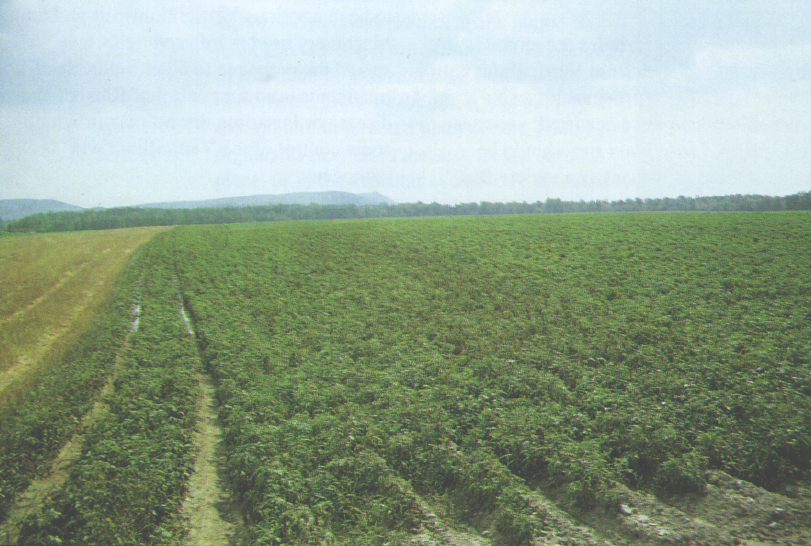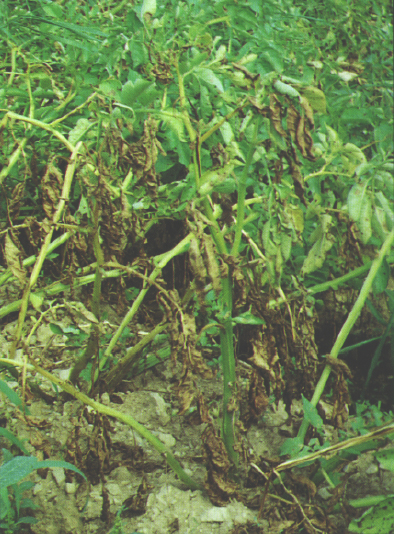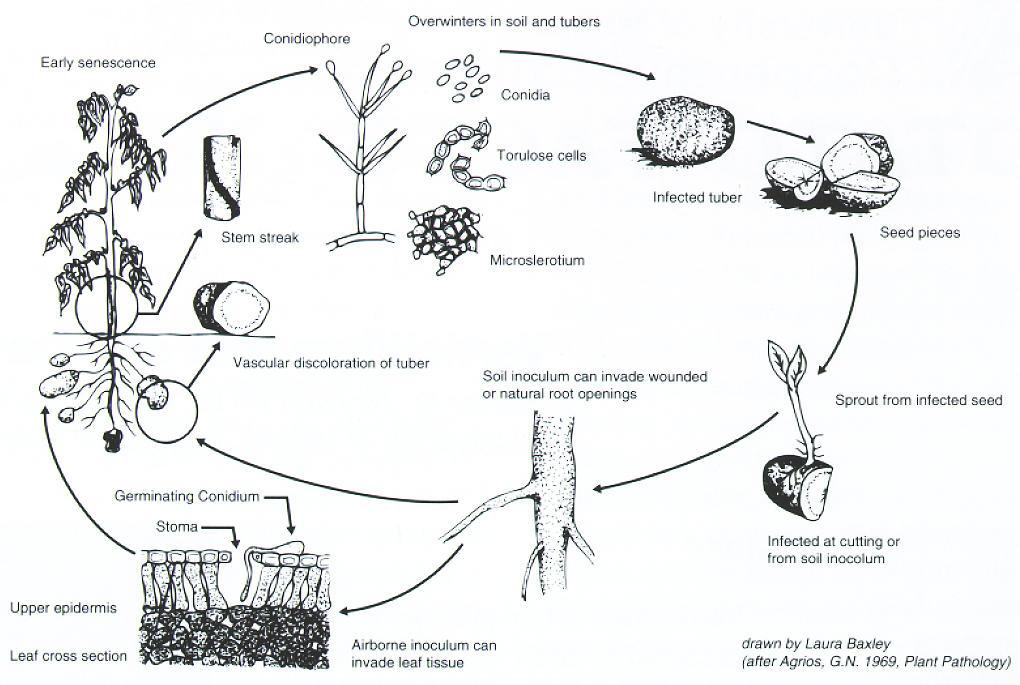Bulletin #5041, Verticillium Wilt of Potatoes
Potato Facts
By Steven B. Johnson, Ph.D., Extension crops specialist, University of Maine Cooperative Extension
For information about UMaine Extension programs and resources, visit extension.umaine.edu.
Find more of our publications and books at extension.umaine.edu/publications/.
Bulletin #5041, Verticillium Wilt of Potatoes (PDF)
History

Verticillium wilt of potatoes is a fungal disease caused by either of two species of Verticillium. The disease is found in Maine and in all potato-producing areas of the United States. Verticillium wilt can cause yield losses by a reduction in tuber size. It can also cause stem-end discoloration and reduce tuber quality for the tablestock and the chip market.
Verticillium wilt is caused by either Verticillium dahliae or Verticillium albo-atrum. Verticillium dahliae is the major pathogen causing Verticillium wilt in Maine; Verticillium albo-atrum is of lesser importance. Both Verticillium spp. survive in the soil and in infected plant debris. The organisms may be in the soil, on the seed piece, or in the vascular system of a diseased plant. These pathogens grow through the vascular system of the plant causing it to wilt, usually late in the season.
Life Cycle
The fungus infects the potato plant through the roots and invades the water-conducting tissues, which can result in a premature yellowing and death of the vine. Premature dying of the plant reduces yield. This disease is expressed more in plants under stress, especially water stress.
Both Verticillium species can overwinter on soil on the potato surface, as mycelium in the soil or inside the tuber, and in or on infected plant debris. Additionally, Verticillium dahliae can overwinter in the soil as microsclerotia, which are very small resting bodies.
Some reports document the severity of Verticillium wilt becoming increased with the presence of lesion nematodes (Pratylenchus penetrans). Potato Early Dying is the name given to the disease with these nematodes and these fungi. Relationships with other pathogens have been reported to increase Verticillium wilt severity.
Seed tubers can transmit Verticillium spp., which can result in the long-distance spread of the pathogen. An infested seed tuber usually carries the fungus on the surface. A seed tuber can have infected vascular tissue. The fungus grows from diseased seed pieces into the new plant or grows through the soil to the roots of healthy plants. It penetrates the young roots and will grow through the stolons into the young tubers. Since the fungus may overwinter in infected plant parts, such as the stems, infected plant debris can be an important source for carry-over of the fungus. Verticillium dahliae may also overwinter as microsclerotia.
Verticillium dahliae has been reported to remain in the soil for as long as seven years without a host crop. Verticillium spp. will live on many other plants. At least 140 species of plants are susceptible to the fungi, including weeds common in potato fields such as nightshade, lambs-quarters, and pigweed.
Wilt may be more severe in low fertility soils or water-stressed plants. The pathogen grows and spreads more quickly when soil moisture is high, but the wilt is more severe when soil moisture levels are low. High nitrogen rates tend to delay the onset of the symptoms. Yield losses result from a reduction in tuber size.
Disease Symptoms

Foliar Symptoms: In Maine, symptoms of Verticillium wilt typically are expressed during late August or early September. The time symptoms appear depends upon soil moisture, temperature, fertility level, variety, pathogen population levels, and species of pathogen. Verticillium wilt can affect the top leaves first, causing them to turn yellow and eventually die. When this symptom occurs, the entire stem dies quickly. More typically, the lower leaves turn yellow and eventually die. The stem tends to remain erect rather than flopping over when it dies.
Initial wilt symptoms are followed by yellowing and eventual browning and death of the leaves and stems. Not all stems arising from a seed piece may be affected. Wilting of the leaflets on one side of a petiole often occurs and is an excellent diagnostic characteristic. When an infected stem is cut at the soil line, the xylem, or water-conducting tissues of the stem, may appear brown. With heavy infection, the insides of stems are almost always discolored. The stem xylem becomes yellow and then turns a reddish-brown color. The color often extends through the entire stem and into the tuber. It should be noted, however, that there are many factors other than infection by Verticillium spp. that can cause vascular discoloration.
External stem streaking as a Verticillium wilt symptom has been reported in the varieties Irish Cobbler and Sebago. Stem streaking on affected varieties usually appears with extensive fungal infection under conditions of high soil moisture and fertility. Many potato varieties may become infected with Verticillium dahliae or Verticillium albo-atrum when grown in infested soils, but not show any symptoms.

Tuber Symptoms: When a cross section of an infected tuber is cut from the stem end, the vascular ring may have brown or black discoloration. The discoloration may extend throughout the tuber but usually is present only part way through the tuber. Although the presence of the discolored vascular ring is an important diagnostic characteristic, this symptom is associated with other diseases and physiological factors. This tuber symptom is, not in itself, a complete diagnosis for Verticillium wilt, as not all infected tubers show vascular discoloration. Verticillium spp. do not cause tuber rot. However, some potato varieties may turn pink around the eyes or show pinkish brown blotches on other parts of the tuber when infected with Verticillium spp. Pinkeye is frequently associated with Verticillium wilt, but is not a Verticillium wilt symptom.
Control
Some potato varieties are more susceptible to losses from Verticillium wilt than others. Where previous losses to Verticillium wilt have occurred, varieties resistant to Verticillium spp. should be planted. Russet Burbank is a variety that has shown good yields in Maine in the presence of Verticillium spp.
Prevention is the best way to control this potentially serious disease. Avoid introducing the pathogen into areas not infested. Use high quality seed from fields without a history of Verticillium wilt problems. Avoid repeated planting of fields to potatoes. Repeated planting of potatoes will increase the incidence of the disease. A crop rotation management plan is the best long-term solution to combating Verticillium wilt. Green manure crops are preferred in a rotation, but any crop other than continuous potatoes would improve both the soil and the potato crop. A three-year crop rotation should be a goal even where Verticillium wilt is not a problem. However, reductions of pathogen populations have resulted from one or two seasons out of potatoes.
Fields with a history of Verticillium wilt should have the potato tops raked and burned. Seed growers should seriously consider burning all potato vines, as this will reduce the amount of fungus returned to the soil. Additional benefits in disease and insect control will result from raking and burning the vines.
Do not plant potatoes in fields known to have a serious Verticillium wilt problem. Machinery used in infested fields may spread the pathogen to other fields. Seed treatments used for control of Rhizoctonia disease or Fusarium dry rot may provide some control of the Verticillium wilt pathogens.
Produced in part with funds from the Maine Potato Board Education Committee.
Information in this publication is provided purely for educational purposes. No responsibility is assumed for any problems associated with the use of products or services mentioned. No endorsement of products or companies is intended, nor is criticism of unnamed products or companies implied.
© 1995
Call 800.287.0274 (in Maine), or 207.581.3188, for information on publications and program offerings from University of Maine Cooperative Extension, or visit extension.umaine.edu.
In complying with the letter and spirit of applicable laws and pursuing its own goals of diversity, the University of Maine System does not discriminate on the grounds of race, color, religion, sex, sexual orientation, transgender status, gender, gender identity or expression, ethnicity, national origin, citizenship status, familial status, ancestry, age, disability physical or mental, genetic information, or veterans or military status in employment, education, and all other programs and activities. The University provides reasonable accommodations to qualified individuals with disabilities upon request. The following person has been designated to handle inquiries regarding non-discrimination policies: Director of Equal Opportunity and Title IX Services, 5713 Chadbourne Hall, Room 412, University of Maine, Orono, ME 04469-5713, 207.581.1226, TTY 711 (Maine Relay System).


